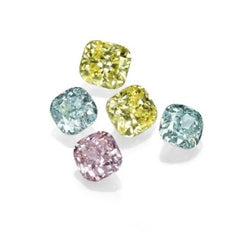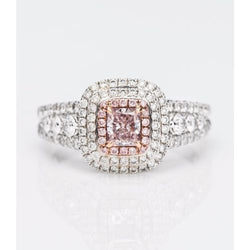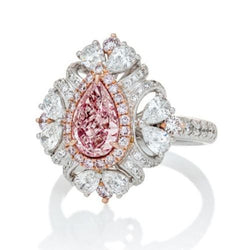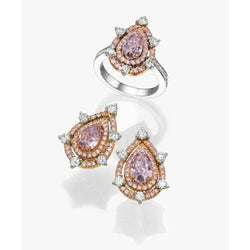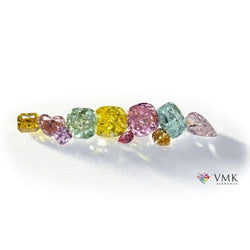Your Cart is Empty
Understanding Fancy Color Diamonds
All the fancy color diamonds we have here at VMK are accompanied by a Gemological Institute of America (GIA) report, and are all natural color.
To understand how colored diamonds are formed, we need to understand how the standard white diamond is formed. Diamonds are formed when pure carbon is put under the extreme conditions of heat and pressure about 90 km under the earth's surface. During intense natural gas explosions diamonds can be carried up to the surface to be mined.
Diamonds can become colored due to changes in the electronic structure as they journey to the Earth’s surface, exposure to radiation, or inclusions of other minerals besides carbon. The intensity and combination of these factors, in addition to other environmental factors, will give each diamond its own characteristics.
The main fancy colors are:
COLORS AND OVERTONES
Fancy colored diamonds are often not one single pure color, but rather contain colored inclusions referred to as “overtones”. These overtones can be of various combinations and intensities, and can create marvelous enhancements to the primary colors. Overtones occur visibly and plainly based on the color wheel; as an example, a pink diamond can have overtones of brown or orange, but not green. Additionally, the even rarer chameleon diamonds are able to change color based on different heating and lighting conditions of the wearer.
COLOR ATTRIBUTES
According to the GIA there are 3 main elements for grading a fancy color diamond’s color, hue, tone, and saturation. Evaluating the differences requires expertise, and a highly trained eye.
Hue: Hue refers to the tint of the main color present in the diamond, usually along with the overtones (aka modifiers). The GIA uses eight main hues in their grading system: Pink, Red, Orange, Yellow, Green, Blue, Violet, and Purple that can be combined into 27 hues. Pink is considered a shade of Red, yet it has its own range on the color wheel, as a primary or secondary color.
Hues with more than one color are described as a main color modified by a secondary, or tertiary color. For example, a Yellowish Green diamond has a dominant Green hue with a secondary hue of Yellow. It is important to note that the last color mentioned is the main color. A Yellow Green diamond would have equal amounts of Yellow and Green hues. Brown and Gray can be used as modifiers for certain hues and only occasionally stand alone with a “fancy” designation.
Tone:This characteristic defines how light or dark the primary color of the hue is.
Saturation:This refers to the strength or purity of the primary color.
The GIA does not measure the percentage of each color, rather the diamond’s main color is established first and modified afterwards (e.g. A Green Yellow diamond contains almost equal amounts of green and yellow, with a slight edge toward yellow and a Greenish Blue diamond is primarily blue and has green overtones)
COLOR SATURATION
Fancy color saturation is most commonly graded on a scale developed by the GIA (Gemological Institute of America), ranging from “Faint” and “Very Light” (which are not even classified as fancy color), to “Fancy Deep” and “Fancy Vivid”- vibrant color that bursts out of the stone.
COLOR DISTRIBUTION
Finally, the last factor to consider when evaluating a diamond’s color is the color distribution. This describes how evenly the color extends across the diamond and is either considered “even” or “uneven”. A stone’s value becomes higher the more evenly color is distributed throughout.
COLOR GRADING
A combination of hue, tone, and saturation, along with the color distribution, collectively designate a fancy color diamond’s properties. In order to fall into the category of fancy colors, a diamond must have either a dark enough tone or strong enough saturation, and perhaps even both. The following is a list of how these different properties are combined into grades on the GIA’s seven-point scale:
Faint: Lowest tone and saturation, with a barely discernable hue. This corresponds to grades K-M on the “colorless” scale.
Very Light: Low in tone and saturation and a very light, but clearly detectable hue. This corresponds to grades N-R on the “colorless” scale.
Light: Low tone and weak saturation, corresponding to grades S-Z on the “colorless” scale.
Fancy Light: Less than 50% saturation and tone, with a vibrant, yet pale, hue
Fancy: The middle range of the fancy colors scale, designating a moderate amount of saturation and tone
Fancy Intense: Containing above-average tone and saturation
Fancy Dark: Displaying a darker tone but weaker saturation
Fancy Deep: The highest level of both saturation and tone
Fancy Vivid: Strong saturation but only a moderate tone



 Pink
Pink Yellow
Yellow Green
Green Chameleon
Chameleon Blue
Blue Purple
Purple Violet
Violet Red
Red Orange
Orange Brown
Brown Gray
Gray Black
Black White
White Colorless
Colorless Radiant
Radiant Cushion
Cushion Pear
Pear Round
Round Heart
Heart Half Moon
Half Moon Baguette
Baguette Emerald
Emerald Asscher
Asscher Princess
Princess Marquise
Marquise Oval
Oval Shield
Shield Trapeze
Trapeze